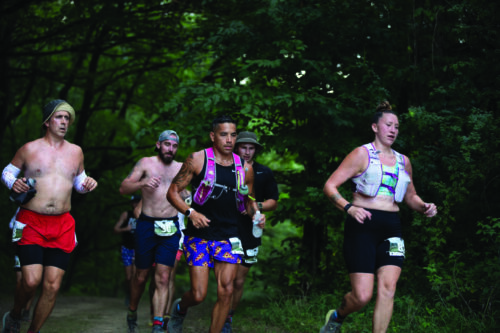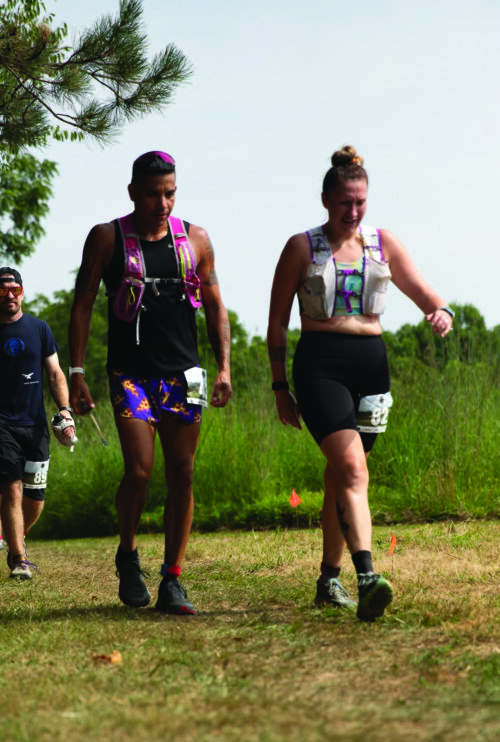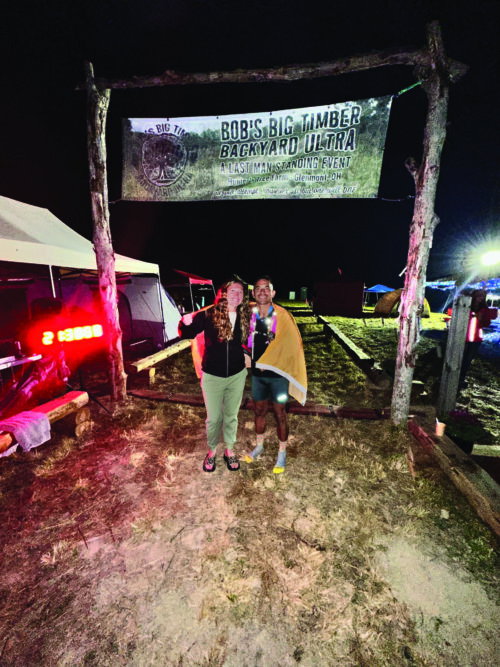By SCOTT MCKIE B.P.
One Feather Asst. Editor
For one Cherokee couple, challenging themselves in their running is not only a passion, it’s a way of life. Kallup McCoy II and Katelynn Ledford-McCoy, husband and wife and both members of the Eastern Band of Cherokee Indians, competed recently in the Bob’s Big Timber Backyard Ultra Last Runner Standing event in Glenmont, Ohio.
“The format of this event is that you complete a 4.167 mile loop, every hour on the hour, until you cannot continue or you do not make it back into the starting line corral within that hour,” Kallup explained. “Whatever time you have to spare within that hour, is the time you get to use to rest and recover. For example, if you finish the loop in 51 minutes, then you have 9 minutes before the next loop begins. The race goes on until there is one runner left.”

Kallup McCoy II (front center) and Katelynn Ledford-McCoy (right), husband and wife and both members of the Eastern Band of Cherokee Indians, are shown competing recently in the Bob’s Big Timber Backyard Ultra Last Runner Standing event in Glenmont, Ohio. (Photos contributed)
Kallup ran 21 laps totaling 87.5 miles in 21 hours, and Katelynn ran for 14 laps totaling 58.3 miles in 14 hours.
Both have competed in ultra races before such as marathons and Ironman events, but this was a first for an event like this.
Kallup noted, “I was relying on the strength and fitness that I had built over the past couple of years from marathon training. I didn’t train a whole lot specifically for this race. We really just decided to do this race on whim, two weeks prior during one of my wife’s training runs.”
Katelynn is currently preparing for a 100-mile ultra-marathon and has been battling a case of plantar fasciitis as well. “I have been slowly getting back into running. I really didn’t start turning up the distance and elevation until July, which was super helpful for me to be prepared in this Last Runner Standing event. I have been running a lot in our local area like Deep Creek and the Mingus Mill trail, which are two of my favorite trail runs for training.”
She added, “I feel like all of the events I have competed in over the years have all helped me to get prepared for this specific race, mentally. Knowing that I have completed challenging events such as Ironman, Spartans, and other ultramarathons, that helped me to wrap my mind around the thought that the pain during an ultra is only temporary.”
Having recently competed in the Missoula, Mont. Marathon, Kallup changed his training up a bit and joined his wife on the trails. “I realized I have been missing the trails, and wanted to change things up a bit. We live our life in such a way that we follow this acronym- BYLR (build your life resume)- which is where we do things unscripted, out of our comfort zone, and just say yes to signing up for things. We can come up with a million reasons to talk ourselves out of doing something, whether that is physically, in our daily life decisions, work endeavors, etc., or we can subscribe to the BYLR way of life which enhances our lives to be brave, be willing, make memories, and live our life in a way that is meaningful to us.”
The format of the Last Runner Standing event was different for them as well and offered interesting challenges.
Kallup commented, “With marathon training, it’s about how fast you can run, while not crossing that red line, and finishing quickly. With this event, it’s almost the exact opposite. It’s about being patient, slowing down, how long you can endure the suffering and discomfort, and then the race doesn’t even really start until you get to that point of experiencing the discomfort and urge to quit. The marathon is a distance that is short enough to race, but long enough to cause suffering and you know when it will end. The last runner standing event is one where you never know when it is going to end, and that’s hard for you to wrap your mind around.”
 Katelynn noted, “You have to welcome the pain. I know that sounds crazy, but the pain is unavoidable. You cannot enter into a race like this with the expectation or mindset that everything is going to go smooth, and that you will be able to cheat the pain. It doesn’t work that way. This kind of event not only tests you to the physical limits, but your mental as well.”
Katelynn noted, “You have to welcome the pain. I know that sounds crazy, but the pain is unavoidable. You cannot enter into a race like this with the expectation or mindset that everything is going to go smooth, and that you will be able to cheat the pain. It doesn’t work that way. This kind of event not only tests you to the physical limits, but your mental as well.”
Doing an event such as the Last Runner Standing presents mental and physical challenges unlike other races, and this included making sure they stayed hydrated and properly nourished throughout the event. “We both hydrated with water, Pedialyte, and Powerade,” said Kallup. “I also drank pickle juice from time-to-time.”
He added, “Making sure you eat is vital during an ultramarathon, so I ate a little bit of everything that my body could stomach. Sometimes it was turkey and cheese in a spinach wrap, pineapples, and watermelon. When the nighttime loops hit, I needed a change up in food so I smashed three pieces of pizza, mashed potatoes, and ramen soup.”
Katelynn ate turkey and cheese wraps during her Ironman race and stayed with those and added some other options. “I went with what I knew would work for my body during extreme physical exertion. The people at the aid station also made grilled cheese and cheese quesadillas which were divine, and I ate fruit. It was pretty hot so when they offered frozen ice pops, I was thankful. I also carried bottles of water to dump on myself while running to keep from overheating.”
Kallup said he was happy with his race. “I was shooting to run 100 miles, which would have gotten me a buckle, but I am really happy with my performance and effort. As I had finished lap 19 and was entering the corral, I said to the race director and my friend Bob, ‘Not too bad for a marathoner’.”

Draped in the flag of the Eastern Band of Cherokee Indians, the two pose at the finish line.
Katelynn, who has the ultra-marathon coming up, had a different goal and was also happy with her performance. “When Kallup first suggested that we go run this event, it didn’t take me long to say yes, as I figured I could use it as a long training run. So we went into this event with the intention of pulling me out after a decent distance so that I wouldn’t hinder my ongoing training for my goal race, knowing I would now have to include recovery time.”
What an athlete does to recover physically following a contest is many times just as important as pre-training, and that was especially true following this event.
“Sleeping and eating more to replenish the body,” said Kallup. “We hobbled around for two days before we could actually start walking normal again. We gave our bodies extra days of no running to recover, and after four days we went on a bike ride to flush the legs out. After that we felt pretty good. We like to use the Hyperice massage gun for our muscles and tendons, and we also took several epsom salt baths.”
Katelynn visited a sauna house for hot/cold therapy to help with inflammation.
The couple said they’d like to thank Nancy Pheasant, Katelynn’s mother, and Cocoa Bean, their Frenchie, for helping them during the race as a pit crew. “Having a crew there helps boost morale and takes out a lot of the stress a runner might have trying to do everything on their own. She did a fantastic job at helping us refill hydration and preparing our nutrition.”





